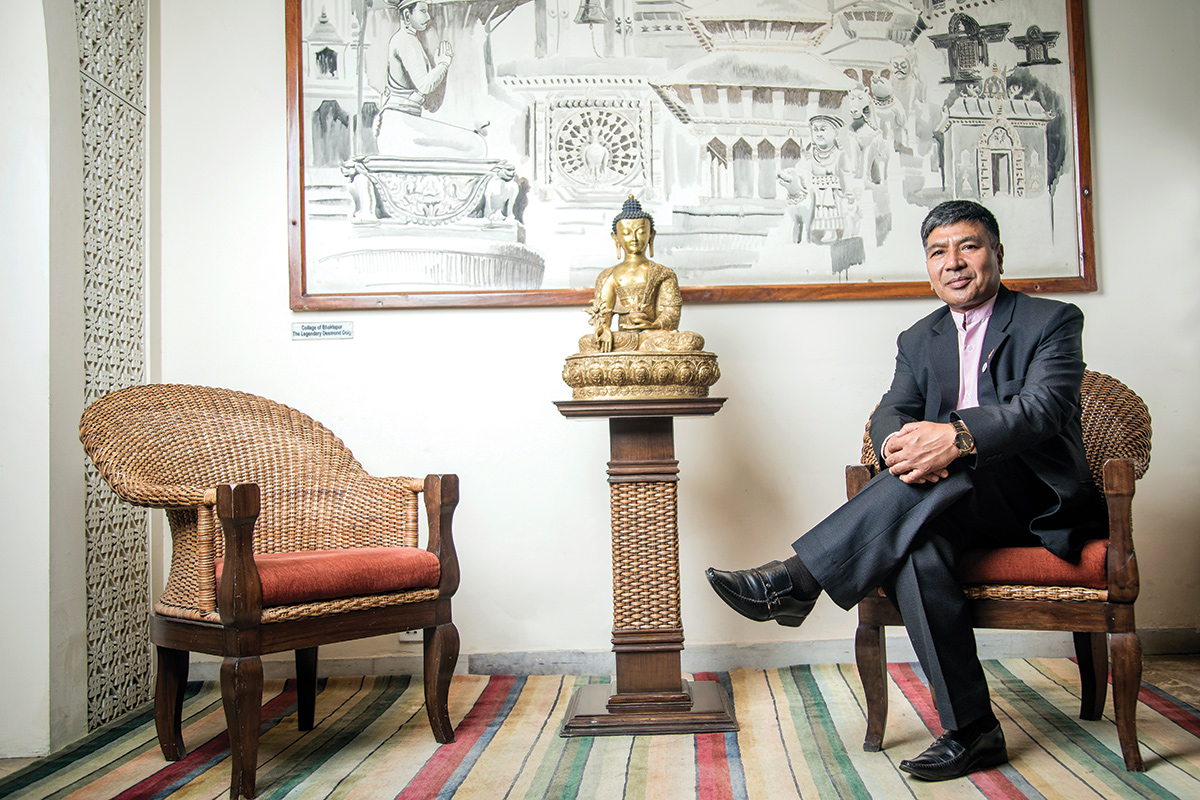
Text by Ankita Jain
Dr. Subarna Das Shrestha - the name stands for the man who returned to Nepal with a vision to develop the hydropower sector. Shrestha holds the position of Chief Executive Officer of Sanima Mai Hydropower Ltd and has been with the Sanima Hydro Group since its inception. He has been involved in the field of hydropower development and environmental assessment for more than two decades. His years of experience has rewarded him with a wide range of knowledge especially on matters related to the technical aspects, policies and acts that concern hydropower development in Nepal and the environmental and social requirements /procedures and financial aspects that hydropower projects entail.
In addition to his work with Sanima Hydropower Group, Shrestha is also actively involved in proliferating the hydro energy sector in Nepal. He has held the post of President in the Independent Power Producers’ Association Nepal (IPPAN) and under his guidance IPPAN successfully conducted the Power Summit in 2013. He actively participated in policy reforms as well as lobbied for private sector friendly policies, regulations and their prompt and effective implementation. He was a member of the Electricity Tariff Fixation Committee, Government of Nepal, and currently serves as a member of EIA Review Committee of the Ministry of Forest and Environment. Being a responsible and visionary hydropower developer, Shrestha is recognised for his work with immense respect and admiration.
The beginning
At a young age, Shrestha had made up his mind to study hydropower engineering. To shape his dream into reality, he applied for a government scholarship, the only way to get the opportunity to study abroad. “I opted to study in Moscow, Russia and out of many, only six were selected for the scholarship and I was one of them,” he recalls. He studied in Russia for six years and returned to Nepal in 1992 when the hydropower development policy was introduced and the government opened doors for the private sector to enter hydropower. But after several attempts, he moved back to Russia disappointed. “The legal framework wasn’t clear and the government had no faith in the people willing to work in the hydropower sector. They believed the sector belonged completely to foreign experts,” he shares.
Later, he completed his Ph.D. in Technical Sciences (Hydro-technical and Land Reclamation) in Russia. And with this achievement, he had several opportunities to work worldwide. “I was trying for Canada. And almost everything was in order. Later I realised whatever I will do in a foreign land, it won’t give me satisfaction. Instead, a small step towards development in my own country would,” says Shrestha, who returned home with much more confidence in 1999. He laid the foundation of Sanima Hydropower, a private company responsible for 2.6 MW Sunkoshi Small Hydropower Project which has been providing electricity to the national grid since 2005. The primary shareholders of the group are Non Resident Nepalis, represented by engineering professionals. “We had set small goals and were working rigorously to achieve it,” he smiles.
Crisis management
Sunkoshi project was not only his first project but also the one with several hurdles. From land acquisition to working during the insurgency, he had to manage everything with patience and fortitude. “Land acquisition is a major problem even today. During the Sunkoshi project, the market price of each ropani was Rs 10-15000 but people were asking in lakhs. However, it took several meetings to convince people and bring them to Rs 39000-70000 per ropani,” he says. Talking about the insurgency period, he adds, “We would even walk for days to convince Maoists not to interrupt the work.” He was then advised by people to stop the hydropower work during insurgency and resume only when things got right. When every day looked like a never-ending challenge, there was also a time when major investors of Sanima Hydro wanted to quit and move on. “Things weren’t falling in the right place and the government showed a different picture. But I believed in myself, my investors and my team and we paved our path to success,” he says modestly. This is why many of his colleagues call him the perfect person to manage a crisis.
Hugely inspired by ‘Manjhi – The Mountain Man’, a 2015 film directed by Ketan Mehta, Shrestha strongly believes if you have confidence in yourself, nothing is impossible. The film is based on the life of DashrathManjhi. Manjhi, widely known as the “Mountain Man”, was a poor labourer in Gehlaur village, near Gaya in Bihar, India, who carved a path 9.1 metres wide and 110 metres long through a hill 7.6 metres high, using only a hammer and chisel. “Every time I watch this film, it inspires me to work even harder for the development of the country,” he opines.
Hydropower capacity: present and future

Electricity in Nepal was introduced in 1911 with the establishment of Pharping Powerhouse in Pharping, Kathmandu. And in 1992, the government opened doors for the private sector to invest in the hydropower sector. Nepal’s enormous hydropower potential has been estimated to be around 84,000 MW of which 43,000 MW has been identified as economically viable. Currently, Nepal’s installed hydropower capacity is 1100 MW. Out of which 600MW is produced by the private sector and 500MW by the government. Talking about Sanima Hydro Group, it currently produces 31.6 MW through three projects: Sunkoshi Small Hydropower Project, Mai Hydropower Project and Mai Cascade Hydropower Project. And around 116 MW is under construction. “In another one and a half years, we will tap into two more projects with 285 MW and 56 MW capacities respectively. Overall within five years, we will meet the target of 500 MW. With this we want to be among one of the leading hydropower companies in the private sector,” he claims.
Nepal-India power banking, exchange and trading of electricity
Both Nepal and India stand to benefit from power exchange in different mechanism between each other and tend to complement the electricity demand and supply. Shrestha rightly mentions, Nepal can purchase power from India during peak period as well as in dry season when there is mismatch of demand and supply in India. Similarly, India can import power from Nepal during summer (when Nepal has surplus power) to run fans and ACs and minimise thermal and coal fire plant generation. Power banking is another reliable mechanism that recently Nepal government has set up with India, which facilitates between two countries according to their need in a similar way as reserves deposit in a bank. A similar arrangement is working well between the USA and Canada. He further adds, “There has to be some sort of clear and workable Power Trade Agreement between both Governments of Nepal and India to facilitate power trade between two countries in a broader perspective on private players’ involvement.”
He emphasises that the constraints of power transmission, legal and regulatory restriction across the border must be lifted on both sides to smooth facilitation of trading as well as banking of electricity. He further agrees that the future strategy should be such as to generate huge clean and renewable hydropower energy to reduce thermal based production to protect the environment and save fuel, coal and timber reserve. “It’s time to understand the importance of bilateral and regional co-operation in power trade. Current interest and work of Bangladesh Government is one of the good examples of bringing together neighbouring countries together through electricity. And Nepal could be focal on it. If things fall right, I am sure power exchange will take place, not only between Nepal and India but between South Asian countries through the SAARC Grid,” he explains.
Future of micro hydropower
With major hydro projects becoming increasingly unsustainable due to environmental concerns and high costs, Shrestha suggests connecting these projects with the national grid system. “Connecting micro-hydro plants to the national grid has raised hopes for the sustainability of small scale hydropower projects in Nepal and the speed of the country’s rural electrification,” he explains.
Concept of mixed energy
Experts claim that up to 10% of the energy mix in Nepal could be covered by wind energy, 80% by hydro and 20% by solar. Bringing forward the concept of mixed energy, Shrestha highlights, “During the day time, solar power should be used and the rest of the hours, hydropower should be used. The practice is evident in India.” He further points out, “The problem with solar energy is that we cannot store solar power, whatever comes you have to distribute. Also, effective solar time is 4.5 to 5 hours a day. Hydropower is the main source for industrial and commercial use and the contribution of other sources could be mainly for household consumption”
What’s lacking
In a sector with only a brief history of private sector involvement, the current Power Purchase Agreement (PPA) structure and policy environment is not very encouraging for investment in hydropower, Shrestha stresses. He shares that more than 10 ministries are involved in the process of developing and implementing a hydropower project, including the same number of departments. Hence delays in the process create barriers in achieving the Nepal Government goal of achieving 1500 MW in 10 years. In the five years feasibility study period provisioned, most of the time is taken by licensing and the environmental impact study takes around one and half year. “The process of receiving permissions to cut trees and government land lease in the construction areas takes the developers to the cabinet, thereby further lengthening the process, apart from policy inconsistency. The bureaucrats are the ones who can play a charismatic role in rapid and smooth facilitation for investors by minimising bottlenecks in approval as well as inter-ministerial coordination processes,” he shares. He further adds about the only one market off taker of electricity, Nepal Electricity Authority. “Alike India there should be more authorities like NEA in the market for the betterment of the country creating equal level playing field and competitiveness ultimately benefitting the people of the country.” Talking about Nepal Electricity Regulatory Commission (NERC), he says, “Though not active currently, but the Commission is said to administer the power purchase agreements, fix tariffs and transmission-network charges, and initiate license-compliance monitoring in the beginning and work for creating a competitive market in power sector later on.”
The other challenges in the sector are lack of local awareness, natural calamity, geological risks and more. “Hydropower is directly affected by climate change in the fact that it alters the amount of water available for generation and potentially the seasonal distribution of runoff. In all cases, there will be impacts on the cost of energy production and plant operations,” he says. He further highlights that the major reasons of low capacity addition lie in clearances delays, local issues (law and order problems, agitations, etc.), land acquisition, rehabilitation and resettlement, and contractual disputes between contractors and companies.
Lifespan and return on investment
While hydro systems have very long operational lives, Shrestha claims the lifespan of hydro projects in the country to be over a century. He also stresses that within 35 years of generating a license, it has to be handed over to the Nepal Government free of cost. “Private investment building hydropower plants under build, own, operate and transfer (BOOT) mechanism is a modality of PPP, which is one of the modalities recognised by hydropower development policy of Nepal. Under BOOT modality private sector not only mobilises funds to create hydro assets by implementing the project but also manages the assets till the time of its handover to the Government of Nepal,” he says. Since the project uses natural resources, it is bound for certain royalty to the government. “For the first 15 years, we need to pay 2% energy royalty and Rs 100 capacity royalty whereas after 15 years, 10% energy royalty and Rs 1000 capacity royalty,” he adds.
About return of investment, he points out, “The first 10-12 years the company concentrates on returning bank interest and loans and a certain amount of dividend to the investors such as 10 to 20 %. Also, our Project Mai & Cascade Hydro ( 29 MW) gave 15% return last year which is equal to 30% if there was no right shares issued. Further we have invested in 73 MW Middle Tamor, 28.1 MW Lower Likhu, 14.3 MW Mathillo Mailung and more which after its completion in 3 to 5 years will start giving more returns to share holders. Post loan pay back period a return from hydro plant gives 20-40% of return globally.” Talking about Sunkoshi plant, he mentions that there has been no return so far despite being 14 years in operation due to natural calamities while the other hydro projects are contributing 15% return to the company.
Environmental impact
Classifying hydropower as renewable can help in attracting private investments and importantly selling power with its clean and low carbon emissions status. Several countries including the UK and Brazil consider hydro as renewables. “Hydropower is clean energy and must be recognised that way. Especially the locals should be made aware about the advantages of a hydro eneregy,” he says. He also feels that current requirement is to look at reservoir projects so that it not only assures electricity but also meet peoples’ requirement of drinking water supply, irrigation and continues the natural hydro cycle.
Besides business
There are various activities people do to relax. Some meditate while a few read and involve in sports. For Dr. Subarna Das Shrestha his work is his meditation. “When I visit hydropower plants, it is equivalent to meditation for me. It is a medium of getting relaxed. In a way, hydro work is similar to the work of a doctor, anytime you might have to visit the field,” he laughs. Also, Shrestha is a spontaneous person. He doesn’t believe in keeping things in the mind and responds to situations then and there. He strongly believes in spending quality time with his family and he is deeply respectful of his mother who he considers to be his inspiration. Also, he shares that his late father supported him throughout but couldn’t see him become an engineer. The success mantra, he reveals, is his ability to take full ownership of any work that he undertakes.



-1744691535.jpg)

-1738054013.jpg)